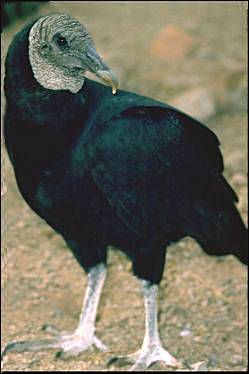
|
Context Kingdom: Animalia |
 |
Black Vulture (Coragyps atratus). Photograph by Dr. Lloyd Glenn Ingles, ©California Academy of Sciences, 2001. |
The Black Vulture measures about 22-25 inches and has a wing span of about 59 inches. Large, broad-winged soaring birds, with short squared-off tails; long thick gray legs and long hooked dark bill; unfeathered, gray head and throat; and plumage is completely black except for white outer primaries. Flies with several quick flaps and a brief glide. Sexes are similar (Robbins et al., 1966).
Coragyps atratus prefers open spaces and often avoids dense forests. Its habitats are lowlands with adjacent highlands, desert terrain, urban or rural centers, and open fields. Black Vultures are found in temperate and tropical climates (Elliot, 2001).
This species is found primarily from southern Arizona east through Chihuahua, western Texas, eastern Oklahoma, Missouri, southern Illinois, southern Indiana, central Ohio, south-central Pennsylvania, and New Jersey south to the Gulf Coast and southern Florida. It also occurs throughout Middle America and South America to central Chile and central Argentina, Trinidad, and Margarita Island (American Ornithologists' Union, 1983).
Black Vultures are scavengers that feed on carrion, mainly road kill. However, they also feed on domestic ducks, small mammals and birds, and rotten fruit or vegetables. These birds are also opportunistic and tend to overeat when food is available (Elliot, 2001).
Black vultures are monogamous breeders. These birds hatch one brood per breeding season. There is no nest. The eggs are laid in a cave, rock crevice, hollow tree trunk, stump, or on the ground under vegetation. They may be moved within the general nesting area (Leahy, 1982). Two eggs that are pale grey-green or pale blue with brown spots are usually laid. Both female and male incubate the eggs for 32-41 days. The young leave the nest after 63 to 70 days after hatching. Hybrids between a Black Vulture and a Turkey Vulture have been observed in captivity (Elliot, 2001).
Although the Black Vulture is a very common bird, this species was blue-listed in 1972. One of the reasons was its decrease in numbers due to the effects on nesting sites because of forest fire control and because of eggshell thining from pesticides. Populations have now expanded and this bird is considered a pest in some places (Elliot, 2001).
The Black Vulture is also known as the Carrion Crow, Black-headed Buzzard, Jim Crow, and Black Buzzard (Forbush and May, 1955). They use their keen sense of smell as well as sight to help them locate carrion (Perrins and Middleton, 1985). Vultures lack most of the mechanisms necessary to vocalize; therefore, they make faint hisses, grunts, and barks (Leahy, 1982).
American Ornithologists' Union. 1983. Check-list of North American birds, 6th ed. Allen Press, Lawrence, 877 pp.
Elliott, G. 2001. "Coragyps atratus" (On-line), Animal Diversity Web. Accessed 2 March 2006 at http://animaldiversity.ummz.umich.edu/site/accounts/information/Coragyps_atratus.html.
Leahy, C. 1982. The birdwatcher's companion: an encyclopedic handbook of North American birdlife. Hill and Wang, New York, 917 pp.
Robbins, C.S., B. Bruun, and H. S. Zim. 1966. Birds of North America. Western Publishing Company, Inc., New York.
Lisa Garcia, March 2006, and Mary Kirschenbaum, July 1996.
